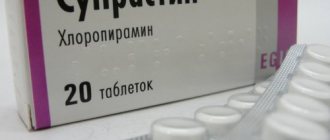pharmachologic effect
The therapeutic property of the drug is due to its pronounced antihistamine effect. It belongs to the 2nd generation drugs, due to which a longer pharmacological effect is observed. It does not affect the nervous or cardiovascular systems and is characterized by the absence of sedation.
Loratadine exhibits a complex pharmacological effect, helping to relieve itching, exudative processes and other signs of allergy. Helps reduce tissue swelling and relieve muscle spasms.
The therapeutic effect is observed an hour after taking the drug and persists throughout the day.
Effect of the drug
The allergy medicine blocks histamine-sensitive receptors, which prevents them from being released from mast cells. As a result, the allergic reaction recedes or the symptoms of its manifestation are alleviated. After taking Loratadine, swelling and itching decrease. In addition, the product allows you to relax spasmodic smooth muscles.
The first noticeable result can be seen 30-40 minutes after administration. The maximum effect is achieved after 8-10 hours and lasts for a day. The components do not depress the central nervous system and are not addictive.
What is Loratadine taken for?
An antihistamine is prescribed for the treatment of:
- Dermatitis, especially contact dermatitis.
- Rhinita.
- Allergic conditions of delayed and immediate type.
- Eczema in the chronic stage.
- Conjunctivitis.
- Insect bites.
- Urticaria in acute and chronic forms.
- Attacks of bronchial asthma.
- Hay fever.
Contraindications and side effects
You should avoid taking Loratadine in the following cases:
- individual intolerance to the constituent components;
- breastfeeding period;
- 1st trimester of pregnancy;
- age up to 2 years.
If the child weighs less than 30 kg, then it is best to give him the drug in syrup form.
People with serious liver diseases and patients with diabetes mellitus should take it with caution.
If you do not follow the instructions, neglect contraindications and permissible doses, the following adverse reactions may occur:
- headache;
- weakness, lethargy, drowsiness;
- dizziness;
- tachycardia;
- feeling of dry mouth;
- alopecia;
- increased appetite;
- changes in kidney function.
Children from 2 to 12 years old may experience adverse reactions in the form of irritability, drowsiness and headache.
There may be cases of overdose, which is manifested by the side effects described above. In this case, you need to rinse the stomach, drink enterosorbent and take care of symptomatic treatment.
Side effects
As a result of neglecting the instructions for use and medical prescriptions, side effects may develop. The most common among them are:
- Dizziness and headache.
- Sleep disturbance, drowsiness or insomnia.
- Fatigue, malaise.
- Dyspeptic disorders.
- Hair loss.
- Allergic signs.
- Strong feeling of hunger.
- Changes in liver function.
In young children from 2 years of age, after using the syrup, headaches, psycho-emotional disturbances, anxiety, fatigue and increased agitation were observed.
Loratadine: how much to drink
To prevent overdose and side effects, it is worth knowing for how long you are allowed to take the medicine.
Adults and children over 12 years of age take 1 tablet once a day. If taken in syrup form, the daily dose is 10 mg.
Children from 3 to 12 years old take ½ tablet per day. The daily dose in syrup form is 5 mg.
The average duration of the treatment course is 1-2 weeks, in some cases the treatment can be extended to 30 days. A more precise duration of the treatment course can be determined by your doctor.
How to take Loratadine
Adult patients and children over 12 years of age are prescribed the drug at a dose of 10 mg per day.
Persons with liver pathologies are recommended to take the drug once every two days in an amount of 10 mg or daily no more than 5 mg.
It is advisable to drink tablets and syrup 10-15 minutes before meals.
For kidney disease and the elderly, no dosage adjustment is required.
The duration of the course of therapy depends on the diagnosis and clinical picture, and is determined by the doctor.
On average, Loratadine is taken for 1-2 weeks. If there is no therapeutic effect, the course may be increased to a month.
If necessary, Loratadine can be combined with other drugs in severe allergic reactions.
Composition and release form
Several companies are involved in the production of the drug. Regardless of the manufacturer, all drugs have the same active ingredient, the same indications, contraindications and adverse reactions.
Available in the following forms:
- pills;
- effervescent tablets;
- syrup.
The active ingredient is loratadine. 1 tablet (including effervescent) contains 10 mg of active ingredient, 5 ml of syrup - 5 mg.
In addition to the active component, the syrup contains other excipients: citric acid, ethanol, water, glycerin, flavoring.
Additional components in the tablets are: corn starch, microcrystalline cellulose, calcium stearate.
Effervescent tablets additionally contain: citric acid, lactose, sodium carbonate, silicon dioxide.
special instructions
In some cases, an antihistamine may cause a dependent sedative effect.
One of the side effects of Loratadine is drowsiness, but it does not affect driving.
If you need to test for an allergen, you should avoid taking the medication a week before the intended procedure.
The drug is based on lactose, so it is contraindicated for persons with intolerance or poor absorption of this substance.
The syrup is prescribed with caution to patients with diabetes mellitus, since refined sugar is included in the composition.
Is Loratadine safe for pregnant women?
The instructions for use in the “Contraindications” section do not say anything about taking Loratadine during pregnancy. The drug should not be given only during breastfeeding.
Taking medication during pregnancy is acceptable provided that the possible benefits outweigh the possible side effects and consequences. If possible, you should stop taking any medications in the 1st trimester of pregnancy, when the fetus is not yet strong enough.
During pregnancy, the following adverse reactions may occur: lack of appetite, nausea, dizziness, changes in heartbeat.
Loratadine
Suction
Quickly and completely absorbed from the gastrointestinal tract. The time to reach the maximum concentration (Tmax) of loratadine in the blood plasma is 1-1.5 hours, and its active metabolite desloratadine is 1.5-3.7 hours. Food intake increases the Tmax of loratadine and desloratadine by approximately 1 hour, but has no effect on the effectiveness of the drug. The maximum concentration (Cmax) of loratadine and desloratadine does not depend on food intake. Cmax of loratadine increases in elderly patients, patients with chronic renal failure or alcoholic liver damage.
Distribution
The bioavailability of loratadine and its active metabolite is dose-dependent. Loratadine has a high degree (97-99%), and its active metabolite has a moderate degree (73-76%) of binding to plasma proteins. Equilibrium concentrations of loratadine and metabolite in the blood plasma are achieved on the fifth day of administration. Does not penetrate the blood-brain barrier.
Metabolism
Metabolized in the liver to form the active metabolite desloratadine (descarboethoxyloratadine) with the participation of the cytochrome P450 isoenzyme CYP3A4 and, to a lesser extent, the cytochrome P450 isoenzyme CYP2D6.
Removal
Excreted through the kidneys (approximately 40% of the oral dose) and intestines (approximately 42% of the oral dose) for more than 10 days, mainly in the form of conjugated metabolites. Approximately 27% of an oral dose is excreted through the kidneys within 24 hours after taking the drug. Less than 1% of the active substance is excreted unchanged through the kidneys within 24 hours after taking the drug. The half-life (T1/2) of loratadine ranges from 3 to 20 hours (average 8.4 hours), and that of desloratadine ranges from 8.8 to 92 hours (average 28 hours).
Pharmacokinetics in special groups of patients
Elderly age
The pharmacokinetic profiles of loratadine and its active metabolite were comparable in adults and elderly healthy volunteers.
T1/2 of loratadine in elderly patients ranges from 6.7 to 37 hours (average 18.2 hours), and desloratadine - from 11 to 39 hours (average 17.5 hours).
Patients with liver dysfunction
In patients with alcoholic liver damage, the Cmax and area under the concentration-time curve (AUC) of loratadine and its active metabolite increase by one-fold compared to these indicators in patients with normal liver function. At the same time, T1/2 of loratadine and T1/2 of its active metabolite increase with increasing severity of the disease.
Patients with impaired renal function
In patients with chronic kidney disease, the Cmax and AUC of loratadine and its active metabolite are increased compared to these values in patients with normal renal function. At the same time, T1/2 of loratadine and T1/2 of its active metabolite do not differ from those in healthy patients.
Hemodialysis in patients with chronic renal failure does not affect the pharmacokinetics of loratadine and its active metabolite.
Loratadine No. 10
Hypersensitivity to loratadine and other components of the drug; lactose intolerance, lactase deficiency, glucose-galactose malabsorption syndrome; breastfeeding period; children under 3 years of age and body weight less than 30 kg.
Overdose
Symptoms: headache, drowsiness, tachycardia. In case of overdose, consult a doctor immediately.
Treatment: symptomatic and supportive therapy. It is possible to lavage the stomach, take adsorbents (crushed activated carbon with water).
Loratadine is not eliminated by hemodialysis. After emergency care is provided, it is necessary to continue monitoring the patient's condition.
Side effect
In clinical studies involving children aged 2 to 12 years, headache (2.7%), nervousness (2.3%), fatigue (1%) were observed more often than in the placebo group (dummies). ).
In clinical trials in adults, adverse events observed more frequently than with placebo occurred in 2% of patients receiving loratadine. In adults, when using the drug, headache (0.6%), drowsiness (1.2%), increased appetite (0.5%) and insomnia (0.1%) were observed more often than in the placebo group. In addition, there have been very rare post-marketing reports (< 1/10,000) of dizziness, fatigue, dry mouth, gastrointestinal disorders (nausea, gastritis), allergic reactions such as rash, anaphylaxis including angioedema, alopecia , liver dysfunction, palpitations, tachycardia and convulsions.
If any of the side effects indicated in the instructions get worse, or you notice any other side effects not listed in the instructions, tell your doctor.
Interaction with other drugs
- Eating does not affect the effectiveness of loratadine.
- Loratadine does not potentiate the effect of alcohol on the central nervous system.
- When loratadine is taken together with erythromycin, ketoconazole or cimetidine, an increase in the concentration of loratadine and its active metabolite in the blood plasma is observed, but this increase is not clinically significant, including according to ECG data.
Carefully
Severe liver dysfunction; pregnancy (see section “Use during pregnancy and breastfeeding”).
*for more details, see the instructions for medical use of the drug LP-005753



